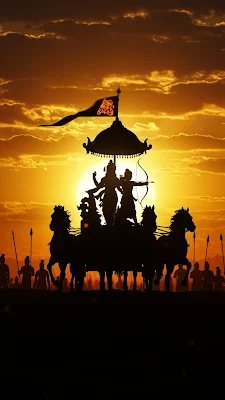Here’s an article exploring Bhagavad Gita Chapter 1, Verse 14 in detail. It covers the Sanskrit verse, transliteration, translation, meaning, and a deeper analysis.
Exploring Bhagavad Gita Chapter 1, Verse 14
Sanskrit Verse
ततः श्वेतैर्हयैर्युक्ते महति स्यन्दने स्थितौ।
माधवः पाण्डवश्चैव दिव्यौ शङ्खौ प्रदध्मतुः॥
Transliteration
tataḥ śvetair-hayair-yukte mahati syandane sthitau
mādhavaḥ pāṇḍavaścaiva divyau śaṅkhau pradadhmatuḥ
Word-by-Word Meaning
- tataḥ – thereafter
- śvetaiḥ hayaiḥ yukte – yoked with white horses
- mahati syandane sthitau – seated in a great chariot
- mādhavaḥ – Shri Krishna (husband of the goddess of fortune)
- pāṇḍavaḥ – Arjuna (the son of Pandu)
- ca eva – also
- divyau śaṅkhau pradadhmatuḥ – blew their celestial conches
Translation
“Then, Madhava (Shri Krishna) and the son of Pandu (Arjuna), seated on a magnificent chariot drawn by white horses, blew their divine conches.”
"तब, श्वेत घोड़ों द्वारा खींचे जाने वाले भव्य रथ पर बैठे माधव (श्रीकृष्ण) और पाण्डुपुत्र (अर्जुन) ने अपने दिव्य शंख बजाए।"
Context and Meaning
This verse sets a significant tone in Bhagavad Gita's first chapter, where both armies are ready for war. The conch blowing is not merely a signal for the start of battle; it carries deep symbolic meaning.
-
Shri Krishna as Mādhava:
The name Mādhava emphasizes Krishna’s divine status, associating him with fortune (as consort of Lakshmi). His role here is not just as Arjuna’s charioteer but as the Supreme Divine, guiding dharma. -
Arjuna as Pāṇḍava:
Mentioning Arjuna highlights his position as the hero of the Pandava side. He represents righteousness, but also the human struggle with doubt and duty, which the Gita addresses. -
The Divine Conches (Divyau Śaṅkhau):
Blowing of divine conches marks a sacred call to arms. It symbolizes courage, righteousness, and readiness for battle in accordance with dharma (duty). -
White Horses and Magnificent Chariot:
White horses stand for purity and spiritual energy. The grand chariot can be seen as representing the body, with Krishna (the soul’s guide) and Arjuna (the individual soul) seated together, symbolizing the inner journey of life and spiritual struggle.
Philosophical Significance
- The conch sound of Krishna and Arjuna instills confidence among their warriors and symbolizes the victory of righteousness over injustice.
- The pairing of Krishna and Arjuna on the same chariot shows the union of divine wisdom and human effort.
- The white horses and chariot imagery also represent the ideal state where the senses (horses) are controlled, and the intellect (charioteer) guides the soul toward its purpose.
Practical Lesson
- In times of personal conflict or duty, one should invoke courage and clarity.
- With the divine guiding us (like Krishna guiding Arjuna), we can face life’s battles with faith and righteousness.
Conclusion
Bhagavad Gita 1.14 is not just a scene from an epic war; it’s a profound moment symbolizing preparation, divine guidance, and the readiness to perform one’s duty, no matter how daunting the task. This verse sets the stage for the wisdom that follows in the dialogue between Krishna and Arjuna.











.webp)
No comments:
Post a Comment